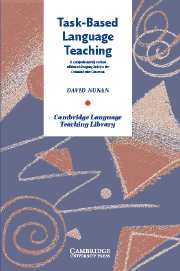Book contents
- Frontmatter
- Contents
- Acknowledgements
- Introduction
- Chapter 1 What is task-based language teaching?
- Chapter 2 A framework for task-based language teaching
- Chapter 3 Task components
- Chapter 4 An empirical basis for task-based language teaching
- Chapter 5 Focus on form in task-based language teaching
- Chapter 6 Grading, sequencing and integrating tasks
- Chapter 7 Assessing task-based language teaching
- Chapter 8 Tasks and teacher development
- Appendix A Approaches and methods – an overview
- Appendix B A unit of work based on the six-step procedure presented in Chapter 2
- Appendix C A unit of work based on the task/exercise typology in Chapter 5
- Appendix D Graded activities for the four macroskills
- Appendix E Common reference levels: self-assessment grid
- Glossary
- Index
Chapter 2 - A framework for task-based language teaching
Published online by Cambridge University Press: 16 February 2010
- Frontmatter
- Contents
- Acknowledgements
- Introduction
- Chapter 1 What is task-based language teaching?
- Chapter 2 A framework for task-based language teaching
- Chapter 3 Task components
- Chapter 4 An empirical basis for task-based language teaching
- Chapter 5 Focus on form in task-based language teaching
- Chapter 6 Grading, sequencing and integrating tasks
- Chapter 7 Assessing task-based language teaching
- Chapter 8 Tasks and teacher development
- Appendix A Approaches and methods – an overview
- Appendix B A unit of work based on the six-step procedure presented in Chapter 2
- Appendix C A unit of work based on the task/exercise typology in Chapter 5
- Appendix D Graded activities for the four macroskills
- Appendix E Common reference levels: self-assessment grid
- Glossary
- Index
Summary
Introduction and overview
In the first section of this chapter, I introduce a framework for task-based language teaching. The framework defines and exemplifies the key elements in the model that underlies this book including real-world/target tasks, pedagogical tasks and enabling skills. The next section outlines a procedure for creating an integrated syllabus around the concept of the pedagogic task. The section that follows is devoted to materials design considerations. It provides a procedure that can be used for planning lessons, materials and units of work. In the final section, the principles underlying the procedures described in the body of the chapter are laid out.
A task framework
As we saw in Chapter 1, the point of departure for task-based language teaching is real-world or target tasks. These are the hundred and one things we do with language in everyday life, from writing a poem to con-firming an airline reservation to exchanging personal information with a new acquaintance. These three examples, by the way, illustrate Michael Halliday's three macrofunctions of language. Halliday argues that at a very general level, we do three things with language: we use it to exchange goods and services (this is the transactional or service macrofunction), we use it to socialize with others (this is the interpersonal or social macrofunction), and we use it for enjoyment (this is the aesthetic macrofunction).
Typically, in everyday interactions, the macrofunctions are interwoven, as in the following (invented) example:
A: Nice day.
B: That it is. What can I do for you?
A: I'd like a round-trip ticket to the airport, please.
Information
- Type
- Chapter
- Information
- Task-Based Language Teaching , pp. 19 - 39Publisher: Cambridge University PressPrint publication year: 2004
Accessibility standard: Unknown
Why this information is here
This section outlines the accessibility features of this content - including support for screen readers, full keyboard navigation and high-contrast display options. This may not be relevant for you.Accessibility Information
- 1
- Cited by
